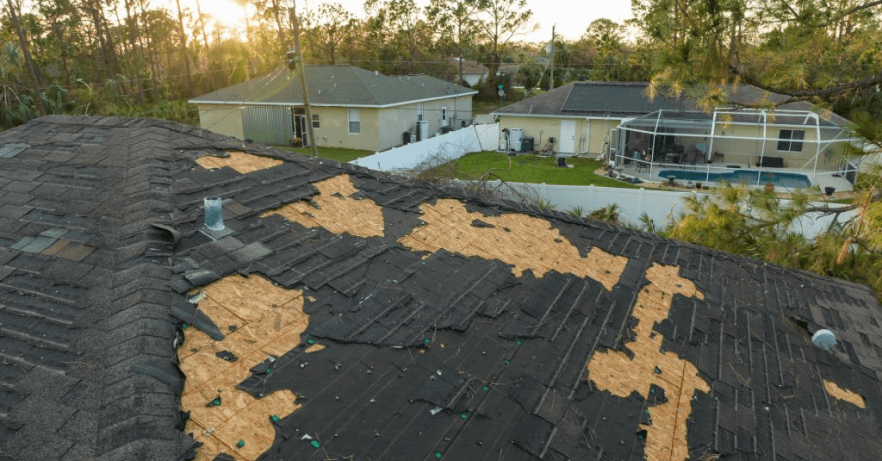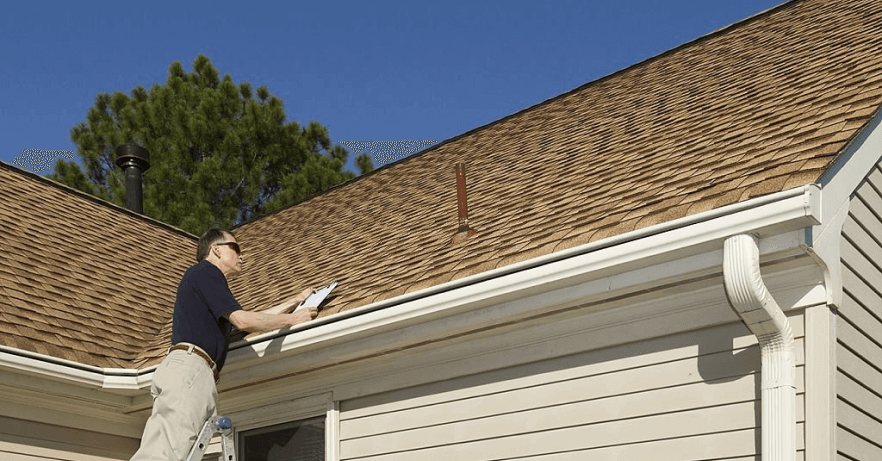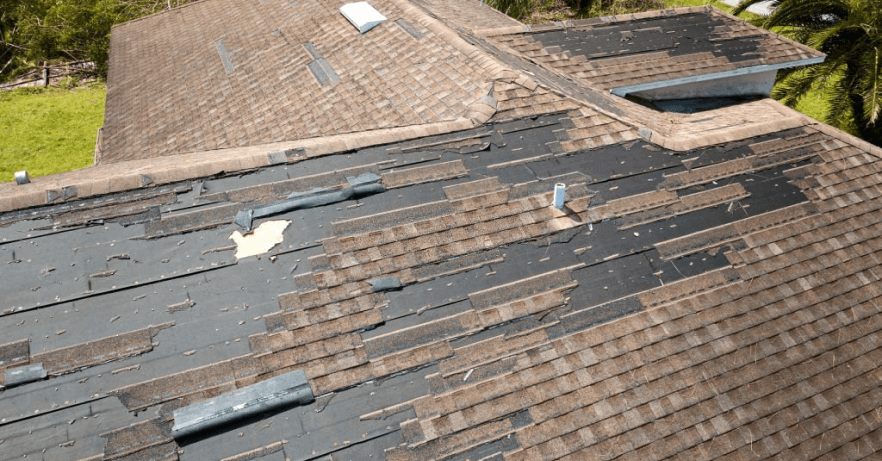Introduction:
There’s nothing quite like watching a powerful thunderstorm from the cozy comfort of your own home. It can be mesmerizing until you hear your roof making strange noises as it battles against the wind and rain. Suddenly, your living room becomes a makeshift swimming pool, and you’re grabbing pots and pans to catch the leaks.
Roofs are supposed to protect us from the weather, but when a big storm hits, they can get damaged by strong winds, hail, and flying debris. The tricky part is that this damage isn’t always obvious. It’s important for homeowners to be able to spot roof damage because fixing it is crucial for your home’s safety and comfort. Ignoring roof problems can even lead to more serious issues down the road.
If you’re reading this article, it’s likely because you’re dealing with storm-related roof damage and looking for guidance on initiating the necessary roof repair process. But before we delve into the repair process, let’s first learn how to identify signs of damage and take prompt action if needed.
Concerned About Storm Damage to Your Roof?
Let Roof Repair Specialists Alleviate Your Worries.
Contact Us for a Free Inspection.
Assessing Storm Damage Safely
Before you venture outside to inspect your home for storm damage, ensuring the storm has passed, and the surroundings are safe is paramount. If you spot downed power lines, electrical hazards, or flooding, maintain a safe distance and promptly seek assistance from relevant authorities or professionals.
However, even after the worst storm has passed, it’s crucial to stay alert for possible dangers, especially when checking your roof. The time right after a storm can make your roof risky because you might not see all the potential problems easily. Here’s what you should watch out for:
- Fallen Trees and Heavy Debris: Scan your roof and its vicinity for any fallen trees or large debris. These can inflict serious damage and compromise the structural integrity of your roof.
- Loose or Broken Shingles: Examine your roof for any signs of loose or broken shingles. These seemingly minor issues can escalate into major leaks and water damage if left unattended.
- Ice Dams (During Winter Storms): Look for ice dams in regions prone to winter storms. These ice accumulations along the roof’s edge can lead to water infiltration and subsequent damage.
Remember, safety should be your top priority during post-storm assessments. Always exercise caution and, when in doubt, consult local roof repair experts like Roof Repair Specialist in Knoxville for a thorough inspection.
Types of Roof Damage After a Storm
The damage your roof may endure can vary depending on the type of storm that hits. Thankfully, in many instances, insurance companies are available to assist with the costs of repairing these damages. Let’s take a closer look at the three most common types of roof storm damage:
- Hail Damage
- Rain Damage
- Wind Damage
The severity of these damages can differ, which is why it’s crucial to have residential roof repair services experts inspect your roof. Their expertise will help you determine the extent of potential issues and the necessary steps for proper repairs.
Identifying Hail Damage
Hail is common in regions where temperatures drop, but it can surprise you anywhere. Hail can pack quite a punch, and its damage is often visibly apparent—it can leave dents in your siding or even break your windows. When it comes to your roof, hail can cause noticeable problems, too.
Here’s what to look for when identifying hail damage to your home’s roof:
- Divots and Dents on Shingles: Hail can leave small dents or divots on your shingles, making them look uneven or pockmarked.
- Broken or Cracked Shingles: Hail can be forceful enough to break or crack shingles, compromising your roof’s protection against the elements.
- Unusual Granules in the Gutters: If you notice an unusual amount of granules from your shingles accumulating in the gutters, it could be a sign of hail damage, as the impact can dislodge these protective granules.
- Dented Metal on Flashing and Gutters: Remember to inspect the metal components of your roof, like flashing and gutters. Hail can cause dents or damage here as well.
Spotting Roof Damage After a Strong Windstorm
High wind speeds can potentially wreak havoc, toppling trees, shattering windows, and causing harm to roofs. Unfortunately, after wind storms, spotting minor damage can be quite challenging. You may need to look closer at your shingles to detect signs of creasing and tearing. When shingles are blown away, they leave the roof deck or underlayment exposed to the elements, increasing the risk of water damage to your home.
Here are a few key areas to carefully inspect following a severe windstorm:
- Shingles: Examine your shingles closely for any creases or tears, as they can be subtle indicators of damage caused by strong winds.
- Flashing: Check the flashing for any signs of damage, as it is essential for preventing water infiltration into your home.
- Roof Deck and Underlayment: If shingles are missing, inspect the roof deck and underlayment for exposed areas, as they are vulnerable to water damage.
- Gutters and Downspouts: Ensure that your gutters and downspouts are intact and functioning correctly to channel rainwater away from your home.
- Chimneys: Inspect your chimney for any loose or damaged bricks, as a compromised chimney can lead to leaks.
After a significant windstorm, you might notice cracks, holes, or even water leakage in your roof. In such cases, it’s advisable to consult a professional roofing company. They can make temporary repairs to mitigate the damage until your insurance company assesses and approves the necessary repairs.
Identifying Water Damage After a Thunderstorm
Unlike wind and hail damage, the aftermath of water damage from a thunderstorm can take some time to become noticeable. This underscores the importance of homeowners in Knoxville staying vigilant. Here are the key areas to inspect for signs of water damage:
- Gutters: Check your gutters for any accumulation of debris or signs of water not flowing properly or being redirected as it should.
- Ceiling: Be on the lookout for water bubbles forming on your ceiling. These can be a clear indicator of water infiltration.
- Walls: Inspect your walls for discolored or peeling paint or wallpaper. These visual cues may signal water damage.
- Roof: Examine your roof for broken, missing, or curled shingles. Damaged shingles can allow water to seep into your home.
- Basement, Attic, and Crawl Space: Keep an eye out for mold growth in these areas, as excessive moisture can lead to mold development.
Related Reads: Why is roof repair important
Starting the Roof Repair Process in Knoxville, TN, After a Storm

When a storm has left your roof seriously damaged, taking swift action is essential to protect your home from further harm. Here’s what you need to do to kickstart the repair process and safeguard your home’s structure:
Prioritize Safety
First and foremost, ensure you, your family, and anyone on your property are safe. If there are any immediate safety concerns, deal with them promptly. This includes covering or boarding up windows with broken or sharp-edged glass and securing any areas that could be hazardous.
Document the Damage
Make sure to capture clear photographs or videos of all the damage inside and outside the affected area. This documentation will be invaluable when you must communicate with your insurance company and roofing professionals.
File Your Insurance Claim
When it comes to filing an insurance claim after storm damage, follow these steps:
- Act Quickly: Report the damages to your insurance company immediately.
- Time Sensitivity: Keep in mind that insurance companies typically require claims to be filed within one year of the damage occurring.
- Use Multiple Channels: It’s best to contact your insurance company through phone and email to ensure effective communication.
- Stay Organized: Maintain a dedicated folder to document all your interactions, including conversations, details, and dates related to your claim.
- Document Damage: Include photo documentation of the damage to provide clear evidence.
- Keep Receipts: If you’ve incurred any expenses along the way, such as temporary housing, retain receipts as proof for potential reimbursement.
Get in Touch with Your Trusted Roofing Contractor
Now is the time to contact experienced roof repair contractors, like our team, who will assess the cost of repair or replacement. We’re happy to provide you with a complimentary roof repair estimate, which you can present to your claims adjuster during your appointment. At Roof Repair Specialists, we also offer assistance with the insurance claims process. We can review your insurance coverage and carefully analyze your claims cases.
In fact, we highly recommend contacting our roof repair insurance claim specialist to inspect your roof and document the damage before contacting your insurance company. By taking this step, we can help you build a compelling case to support your claim, ensuring you receive the necessary assistance to restore your roof to its former glory.
Roof Replacement or Repair
Based on the severity of the damage, our roofing specialists will recommend either a roof repair or a complete roof replacement. Once you give your approval, we will commence the necessary work. We are committed to completing the project within the specified timeline, conducting the required inspections, and ensuring your satisfaction with the final result.
Don’t Neglect Roof Inspection and Repair After a Storm

Preserving your roof’s integrity after a storm is absolutely crucial. Act promptly by contacting Roof Repair Specialists in Knoxville. Our reputation for top-notch services, combining quality and budget-friendly roof repair solutions, guarantees the safety and well-being of your home and family.
Secure Your Roof Today!
